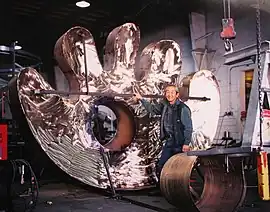| The Mitt | |
|---|---|
 | |
| Artist | Gerard Tsutakawa |
| Year | 1999 |
| Medium | Bronze sculpture |
| Subject | Baseball glove |
| Location | Seattle, Washington, U.S. |
| 47°35′32.0″N 122°20′01.8″W / 47.592222°N 122.333833°W | |
The Mitt (stylized as The MITT) is an abstract bronze sculpture by Gerard Tsutakawa,[1] installed outside Seattle's T-Mobile Park, in the U.S. state of Washington.
Description
The Mitt is installed outside T-Mobile Park (formerly Safeco Field) in Seattle's SoDo neighborhood. The bronze sculpture is 9 feet tall and approximately 12 feet wide.[2] It depicts a baseball glove with a hole (or "abstract circular opening") in the middle.[3][4]
According to the Seattle Mariner's website, "Near the center of the glove an aperture appears as an abstract symbol representing a ball nestled in the leather, or a hole where a fastball burned through. The sculpture is placed outside the gates to allow fans to touch, lean on, or crawl through the work, giving the public a feeling of ownership of the piece."[5] The artwork has become a "beloved spot for selfies, family portraits and meet ups", according to KUOW-FM's Marcie Sillman.
History
.jpg.webp)
The artwork was commissioned and created in 1999.[6][7] It is washed and polished annually.[8]
Reception
The work has been described as "iconic".[6][9][10] In 2017, Marcie Sillman of KUOW-FM wrote, "Seattleites have indeed embraced this sculpture; its surface is worn away in the spots where people climb on it to have their pictures taken. The Mitt has become a city icon, like the Fremont Troll or the Pike Place Market pig [Rachel]."[3]
Tsutakawa has credited the work for boosting his career.[11] According to Sillman, "The sculpture's success helped propel Gerry Tsutakawa into the public eye, earning him more art commissions. But it also helped establish him on an equal artistic footing with another Tsutakawa: his late father George. It also revealed the differences between Gerry's often whimsical world view and his father's more contemplative artwork."[3]
See also
References
- ↑ "New fountain adorns Seattle Center". Seattle Daily Journal of Commerce. October 25, 2000. Retrieved 2023-05-13.
- ↑ "Art in the Park | Seattle Mariners". MLB.com. Archived from the original on 2021-09-07. Retrieved 2023-05-13.
- 1 2 3 Sillman, Marcie (2018-10-24). "Do you know the family story behind Seattle's beloved baseball mitt?". www.kuow.org. Archived from the original on 2022-09-28. Retrieved 2023-05-13.
- ↑ "Japanese Language School memorial to feature work of prominent sculptor | News & Information". University of Washington Tacoma. Archived from the original on 2022-11-29. Retrieved 2023-05-13.
- ↑ Enders, Eric (2018-10-16). Ballparks: A Journey Through the Fields of the Past, Present, and Future. Chartwell Books. ISBN 978-0-7603-6530-4.
- 1 2 "Artists share their visions for pieces at Climate Pledge Arena". KIRO 7 News Seattle. 2021-04-30. Archived from the original on 2022-12-02. Retrieved 2023-05-13.
- ↑ "Gerard Tsutakawa's sculptures have shaped Seattle's landscape for years. Here's how — and what else is coming". The Seattle Times. 2021-09-03. Archived from the original on 2023-02-03. Retrieved 2023-05-13.
In 1999, Gerard created "The Mitt" for Safeco Field (now T-Mobile Park), where it has since stood as a landmark, meeting point and photo...
- ↑ "Ahead of opening day, iconic bronze sculpture outside T-Mobile Park gets annual polish". king5.com. April 6, 2022. Archived from the original on 2022-08-12. Retrieved 2023-05-13.
- ↑ "George and Gerard Tsutakawa's Artistic Legacy Honored in New Wing Luke Museum Exhibit". South Seattle Emerald. 2021-08-04. Archived from the original on 2022-05-22. Retrieved 2023-05-13.
- ↑ "'Salish Sea Circle' is born". Port Townsend Leader. 10 May 2011. Retrieved 2023-05-13.
- ↑ Ray, Roxanne (2021-07-28). "Gerard Tsutakawa shares how being from a family of artists has shaped his life, creativity and career". International Examiner. Archived from the original on 2023-01-28. Retrieved 2023-05-13.